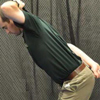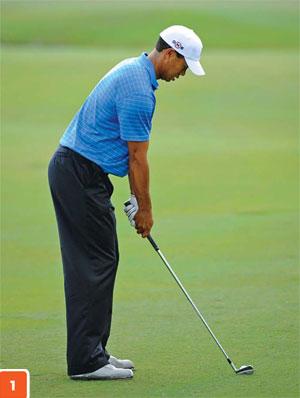In many instances, flawed movement throughout the swing stems from incorrect posture at address. Poor posture at address may also lead to low back pain and stiffness that many amateur golfers experience throughout a round of golf. The most common mistake is made by bending from the wrong area of the body. Many amateurs tend to forward bend from the mid-back (thoracic spine), which is called setting up in C-Posture (due to the rounding of the spine into a C-shape).
C-Posture limits the amount of space your spinal joints have to rotate in the back swing. This will prevent you from having a smooth and complete turn into the back swing which will ultimately cause a loss of posture in the form of a sway or reverse pivot. In other words, setting up with bad posture makes it extremely difficult to achieve consistent ball striking due to excessive body movement throughout the swing. Because poor posture at address causes bad patterning throughout the rest of the swing, the low back is placed under abnormal stress which may lead to pain and stiffness. To simply summarize, setting up in poor posture can ruin the swing before you even pull the club head back
It is easy to see and feel if you are set up in bad posture, but challenging to correct it. First, golfers must have a combination of sufficient flexibility, strength, and coordination to put their bodies into an ideal address posture and to be able to do it on a CONSISTENT basis. Second, they most have a strong understanding on how to initiate the movements necessary to consistently and safely put them into the correct position. Here is a great drill to learn the movement necessary to get into perfect address posture:
Club Behind The Spine Drill:
 Stand tall and place a golf club behind your back with the club face pressed against your tailbone and the grip pressed against the back of your head. Next, flatten your back so your low back is firmly pressed against the club (Picture 1). Now, bend forward in such a way that the club shaft stays pressed against your head, tailbone, and low back THROUGHOUT THE WHOLE MOTION (Picture 2). Bend forward enough for the shoulders to get in line with your toes. This is the ideal positioning for posture at address.
Stand tall and place a golf club behind your back with the club face pressed against your tailbone and the grip pressed against the back of your head. Next, flatten your back so your low back is firmly pressed against the club (Picture 1). Now, bend forward in such a way that the club shaft stays pressed against your head, tailbone, and low back THROUGHOUT THE WHOLE MOTION (Picture 2). Bend forward enough for the shoulders to get in line with your toes. This is the ideal positioning for posture at address.
If you use this club behind the spine drill to practice arriving at an ideal address posture, it will surely help improve all aspects of the swing and the consistency of your game.
[gview file=”https://fitgolf.com/files/2013/04/clubbehindthespine.pdf”]
Download the Club Behind the Spine Exercise here.

